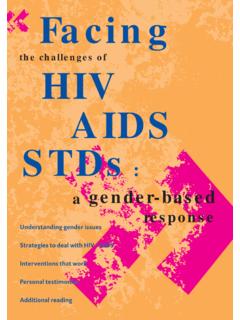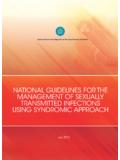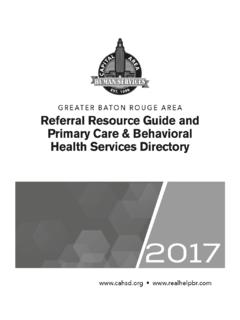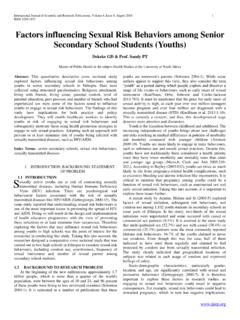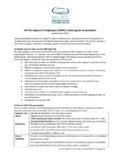Transcription of Estimates of New HIV Infections in the United States
1 C D C F A C T S H E E T AUGUST 2008 Estimates of New HIV Infections in the United StatesAccurately tracking the HIV epidemic is essential to the nation s HIV prevention efforts. Yet monitoring trends in new HIV Infections has historically posed a major challenge, in part because many HIV Infections are not diagnosed until years after they , new technology developed by the Centers for Disease Control and Prevention (CDC) can be used to distinguish recent from longstanding HIV Infections . CDC has applied this advanced technology to develop the first national surveillance system of its kind that is based on direct measurement of new HIV Infections .
2 This new system represents a major advance in HIV surveillance and allows for more precise Estimates of HIV incidence (the annual number of new Infections ) than ever before s first Estimates from this system reveal that the HIV epidemic is and has been worse than previously known. Results indicate that approximately 56,300 new HIV Infections occurred in the United States in 2006 (95% Confidence Interval: 48,200 64,500). This figure is roughly 40 percent higher than CDC s former estimate of 40,000 Infections per year, which was based on limited data and less precise methods (see box on page 5, Historical Challenges in Tracking HIV Incidence ).
3 It is important to note that the new estimate does not represent an actual increase in the annual number of new HIV Infections . In fact, CDC s analysis suggests that the epidemic has been roughly stable since the late 1990s, though the number of new HIV Infections remains unacceptably high. These findings underscore the ongoing challenges in confronting this disease and the urgent need to expand access to effective HIV prevention Technology Allows Clearest Picture to Date CDC s new HIV surveillance system is based on an approach known as STARHS (Serological Testing Algorithm for Recent HIV Seroconversion), which uses innovative testing technology to determine, at the population level, which positive HIV tests represent new HIV Infections (those that occurred within approximately the past five months).
4 Before the widespread availability of this technology, HIV diagnosis data provided the best indication of recent trends in key populations. However, diagnosis data only indicate when a person is diagnosed with HIV, not when an individual is actually infected, which can occur many years before a diagnosis. By applying this technology to new HIV diagnoses in 22 States with name-based HIV-reporting systems, CDC was able for the first time to identify those diagnoses in a given year that represented new Infections . Using a complex statistical model, these data were extrapolated to the general population to provide the first national estimate of HIV incidence based on direct incidence: The number of people who become newly infected with HIV in a given time periodHIV diagnoses: The number of people diagnosed with HIV in a given time period, regardless of when they originally became infected AIDS diagnoses: The number of people diagnosed with AIDS in a given time period.
5 An AIDS diagnosis occurs when an HIV-infected individual s immune system becomes severely compromised (measured by CD4 immune cell count) and/or the person becomes ill with an opportunistic infection. In the absence of treatment, the onset of AIDS normally occurs 8 to 10 years after initial HIV infection. With early HIV diagnosis and treatment, an AIDS diagnosis may be delayed by many D C F A C T S H E E T AUGUST 2008 CDC researchers also used a separate method called extended back-calculation to confirm the official 2006 STARHS estimate and to examine historical trends in HIV Infections in the United States from 1977 to 2006.
6 The method uses a statistical model that considers all HIV and AIDS cases diagnosed in the through 2006 and reported to CDC, as well as HIV testing patterns. Extended back-calculation has become possible in the United States because of an expanded name-based HIV reporting system, which provides a population-based system for identifying new diagnoses. However, the method is an indirect measure of incidence and is most reliable for earlier years; data for the most recent years (2003 2006) must be interpreted with caution. Additionally, extended back-calculation does not generate single-year Estimates , instead providing averages over multiple-year statistical methods used to develop the 2006 incidence estimate, as well as the extended back-calculation historical trends, were developed in consultation with outside experts, and both the methods and their application underwent rigorous external scientific forward, the STARHS-based surveillance system will provide the most reliable way to monitor incidence trends.
7 Over time, the picture will become even more clear as analyses for specific populations are completed ( , black women, young men who have sex with men). Now that this system is in place, CDC will be able to provide an updated estimate of HIV incidence in the United States on an annual basis. Over time, trend information from this system will allow for improved targeting and evaluation of prevention efforts for the populations at greatest New Estimates HIV Epidemic Worse Than Previously KnownApproximately 56,300 new HIV Infections occurred in the in 2006, according to the new surveillance system.
8 This number is approximately 40 percent higher than CDC s previous estimate of 40,000 new Infections per year, which was based on less precise methods (see box on page 5, Historical Challenges in Tracking HIV Incidence ). It is important to note that the new estimate does not reflect an increase in HIV incidence. In fact, CDC s separate analysis of historical trends, using the extended back-calculation model, indicates that the annual number of new HIV Infections has been roughly stable since the late 1990s (Figure 1). CDC s trend analysis provides a clearer picture of how the nation s epidemic evolved to its current point.
9 The analysis shows that new Infections peaked in the mid-1980s at approximately 130,000 Infections per year and reached a low of about 50,000 in the early 1990s. Incidence then appears to have increased in the late 1990s, but has stabilized since that time (with Estimates ranging between 55,000 and 58,500 during the three most recent time periods analyzed). 140,000120,000100,00080,00060,00040,0002 0,00001977 79 1980 811984 851982 831986 87 1988 90 1991 931994 961997 992000 022003 06 Figure 1. Estimated New HIV Infections , Extended Back-Calculation Model, 1977 2006, OverallNote.
10 Estimates are for 2-year intervals during 1980 1987, 3-year intervals during 1977 1979 and 1988 2002, and a 4-year interval for 2003 D C F A C T S H E E T AUGUST 2008 Data Confirm Most Severe Impact Is Among Gay and Bisexual Men of All Races and Black Men and WomenGay and Bisexual Men of All Races Are Most Heavily Affected by HIVGay and bisexual men referred to in CDC surveillance systems as men who have sex with men (MSM)1 represented a significantly greater proportion of estimated new Infections in 2006 than any other risk group (Figures 2 and 3).










